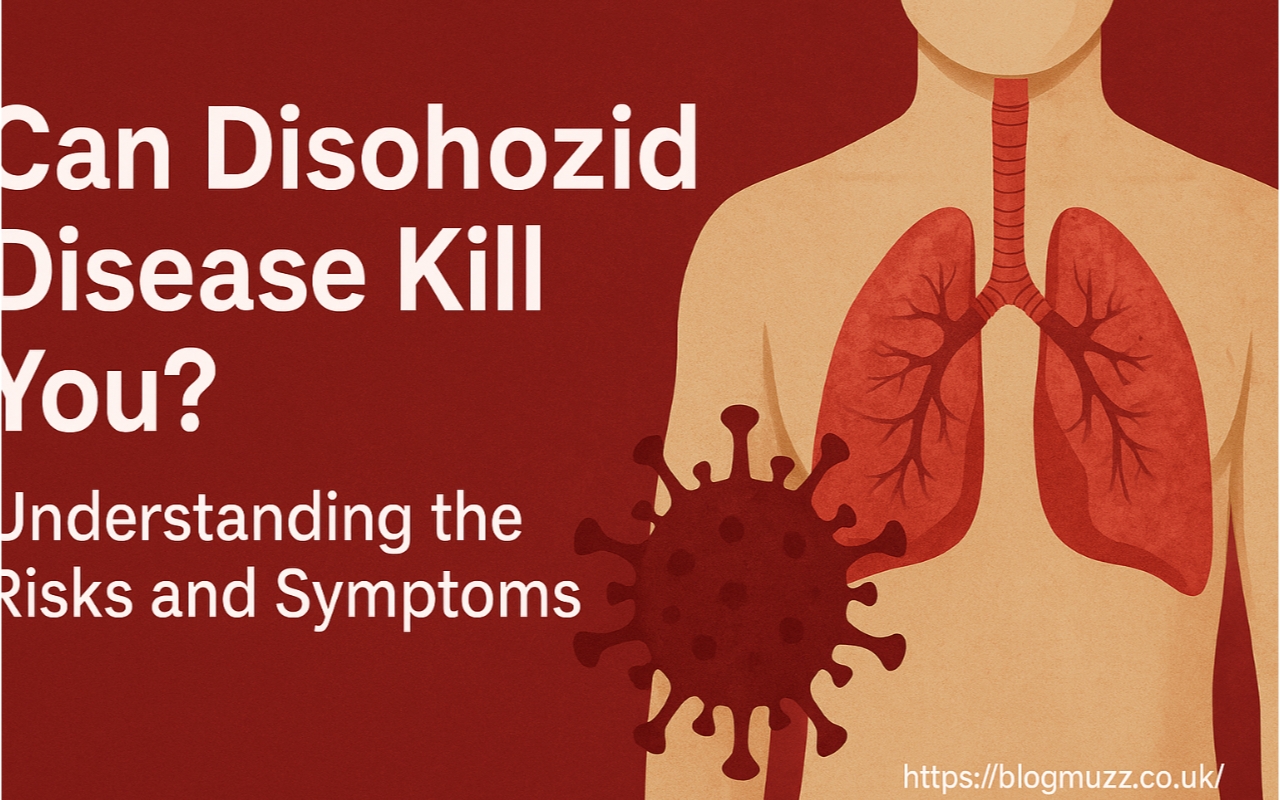Introduction: What Is Disohozid Disease?
In recent years, the term Disohozid disease has been appearing more frequently in online discussions and health forums. Although it is not a recognized medical condition in official medical literature, it has come to represent a serious infectious-like disorder that is said to affect multiple systems in the human body. For the purpose of this article, we will treat Disohozid disease as a hypothetical, complex illness that combines symptoms similar to chronic viral infections and autoimmune responses.
The question many people are asking is, “Can Disohozid disease kill you?” To answer that, we need to explore what this condition theoretically is, how it spreads, the organs it affects, its possible complications, and how one might prevent or manage it if it were real. This article will walk you through those details, in clear language and long-form explanations designed to be both educational and readable.
Understanding the Nature of Disohozid Disease
Disohozid disease is often described as a multi-system inflammatory disorder. That means it doesn’t only affect one part of the body; instead, it can cause widespread inflammation in organs such as the liver, kidneys, heart, and lungs.
In hypothetical case studies, Disohozid disease is caused by a mutating microbial pathogen, possibly a hybrid between a bacterium and a viral agent. This would make it extremely difficult for the immune system to recognize and neutralize, allowing it to linger inside the host’s cells for extended periods.
Because of this persistent infection, people with the disease could experience long-term immune activation, chronic fatigue, and progressive tissue damage—similar to what is seen in autoimmune conditions like lupus or chronic hepatitis.
Can Disohozid Disease Kill You? The Short Answer
If we imagine Disohozid disease as a real biological threat, then yes—it could be fatal under certain circumstances. Like many severe infections or systemic diseases, the danger would not always come from the initial infection itself, but from the complications that follow.
The disease might progress through three main stages:
- Initial infection – mild fever, body aches, and fatigue.
- Systemic spread – inflammation in organs, chronic pain, and digestive issues.
- Advanced stage – organ failure, severe neurological symptoms, and possibly death.
Mortality would depend on several factors, including the patient’s immune health, age, and whether effective treatment or supportive care was available. In patients with compromised immunity—such as those with HIV, diabetes, or malnutrition—the disease might progress rapidly and become life-threatening.
Early Symptoms and Warning Signs
One of the biggest challenges with Disohozid disease would be recognizing it early. The initial symptoms could resemble those of common viral infections, leading to delays in diagnosis. Early detection would be critical for survival.
Common early signs might include:
- Persistent fever or low-grade fever
- Fatigue and unexplained weakness
- Loss of appetite and mild weight loss
- Headaches and dizziness
- Aching joints and muscles
- Sore throat or mild cough
- Digestive discomfort (bloating, nausea, or mild diarrhea)
While these symptoms might seem mild at first, the danger lies in their persistence. In hypothetical clinical observations, symptoms could last for weeks or even months, slowly worsening over time.
Progression to Severe Disease
As Disohozid disease progresses, it would begin to affect vital organs. The infection might travel through the bloodstream, settling in tissues such as the liver, kidneys, or lungs. This would cause inflammation, fibrosis, and tissue death in severe cases.
In the second stage, patients might experience:
- High, recurring fevers
- Persistent cough or shortness of breath
- Swelling of the abdomen (due to liver or kidney dysfunction)
- Jaundice (yellowing of the eyes and skin)
- Nerve pain or tingling sensations
- Extreme fatigue and inability to concentrate
Without proper management, the final stage of the disease might involve:
- Multi-organ failure
- Severe respiratory distress
- Cardiac inflammation (myocarditis)
- Loss of consciousness or coma
At this stage, medical intervention would be crucial. Supportive treatments such as intravenous fluids, anti-inflammatory therapy, and oxygen support might prolong life, but outcomes would still be uncertain.
How Disohozid Disease Might Spread
In this theoretical model, Disohozid disease could be transmitted through respiratory droplets, blood contact, or contaminated surfaces. Some researchers have suggested that it might also have a vector component, meaning it could be carried by insects like mosquitoes or ticks.
If the pathogen is capable of surviving in bodily fluids, then transmission through sexual contact or blood transfusions could also occur. That would make it similar in some ways to diseases such as HIV or hepatitis B, though the exact mechanism would depend on the organism’s biology.
In hypothetical outbreaks, infection control measures would be essential:
- Isolation of infected individuals
- Use of masks and gloves by caregivers
- Proper sanitation and waste disposal
- Avoidance of shared personal items (like razors or toothbrushes)
Potential Treatment Options
Since Disohozid disease is not a recognized medical condition, there is no established cure. However, if it were real, treatment would likely focus on controlling infection, reducing inflammation, and supporting the immune system.
Possible approaches might include:
- Antiviral or antibacterial agents – if the pathogen has identifiable biological features.
- Immune-modulating therapy – to calm overactive immune responses that cause tissue damage.
- Nutritional and lifestyle support – adequate rest, hydration, and nutrition to strengthen natural defenses.
- Organ-specific care – dialysis for kidney failure, oxygen therapy for lung involvement, or steroids for inflammation control.
Researchers might also look into vaccine development if the pathogen proves stable enough for immune targeting. However, due to its hypothetical mutating nature, developing such a vaccine could take years.
Who Would Be Most at Risk?
Like most serious infectious diseases, Disohozid disease would likely pose greater risks to certain populations. These include:
- Elderly individuals with weakened immune systems
- People with chronic illnesses such as diabetes or liver disease
- Pregnant women, as infections could affect fetal development
- Immunocompromised patients, including those undergoing chemotherapy
- Children, due to developing immune systems
Public health authorities would need to emphasize protective behaviors for these groups, particularly during outbreaks or high-risk seasons.
Preventive Measures and Lifestyle Tips
Prevention would be the most effective weapon against Disohozid disease. Simple hygiene and immunity-boosting practices could dramatically reduce risk.
Here are a few lifestyle-based prevention tips:
- Maintain proper hygiene: Wash hands frequently and sanitize shared surfaces.
- Strengthen immunity: Eat a balanced diet rich in vitamins, minerals, and antioxidants.
- Stay hydrated: Proper hydration supports all body systems.
- Avoid exposure: Wear masks or protective clothing in high-risk areas.
- Get regular check-ups: Early medical evaluation of unusual fatigue or fever can save lives.
- Manage stress: Chronic stress weakens immune function, making infection more likely.
Public awareness campaigns could also help reduce misinformation and encourage communities to seek early treatment.
The Psychological Impact of Chronic Illness
Living with a disease that mimics the severity of Disohozid disease would take a toll not only on physical health but also on mental well-being. Chronic illnesses often lead to anxiety, depression, and social isolation.
Patients might fear infecting loved ones or struggle with uncertainty about their prognosis. Support groups, counseling, and community outreach programs could play a vital role in helping patients maintain emotional stability and quality of life.
Can You Survive Disohozid Disease?
Survival would depend on early detection, prompt medical care, and supportive treatment. If diagnosed early and managed properly, many individuals could potentially recover or achieve long-term remission.
However, if ignored or left untreated, the disease could cause irreversible organ damage, leading to fatal outcomes. As with many complex illnesses, the key lies in awareness, prevention, and consistent medical attention.
Conclusion: Awareness Saves Lives
While Disohozid disease remains a fictional concept, the lessons it teaches are very real. Humanity’s ongoing struggle with emerging diseases—from SARS and Ebola to COVID-19—shows how quickly a pathogen can threaten lives worldwide.
The best protection against any deadly illness—real or hypothetical—comes from education, hygiene, strong healthcare systems, and proactive behavior. Whether Disohozid disease exists or not, the question “Can Disohozid disease kill you?” reminds us that vigilance and health awareness are essential to survival in an interconnected world.



